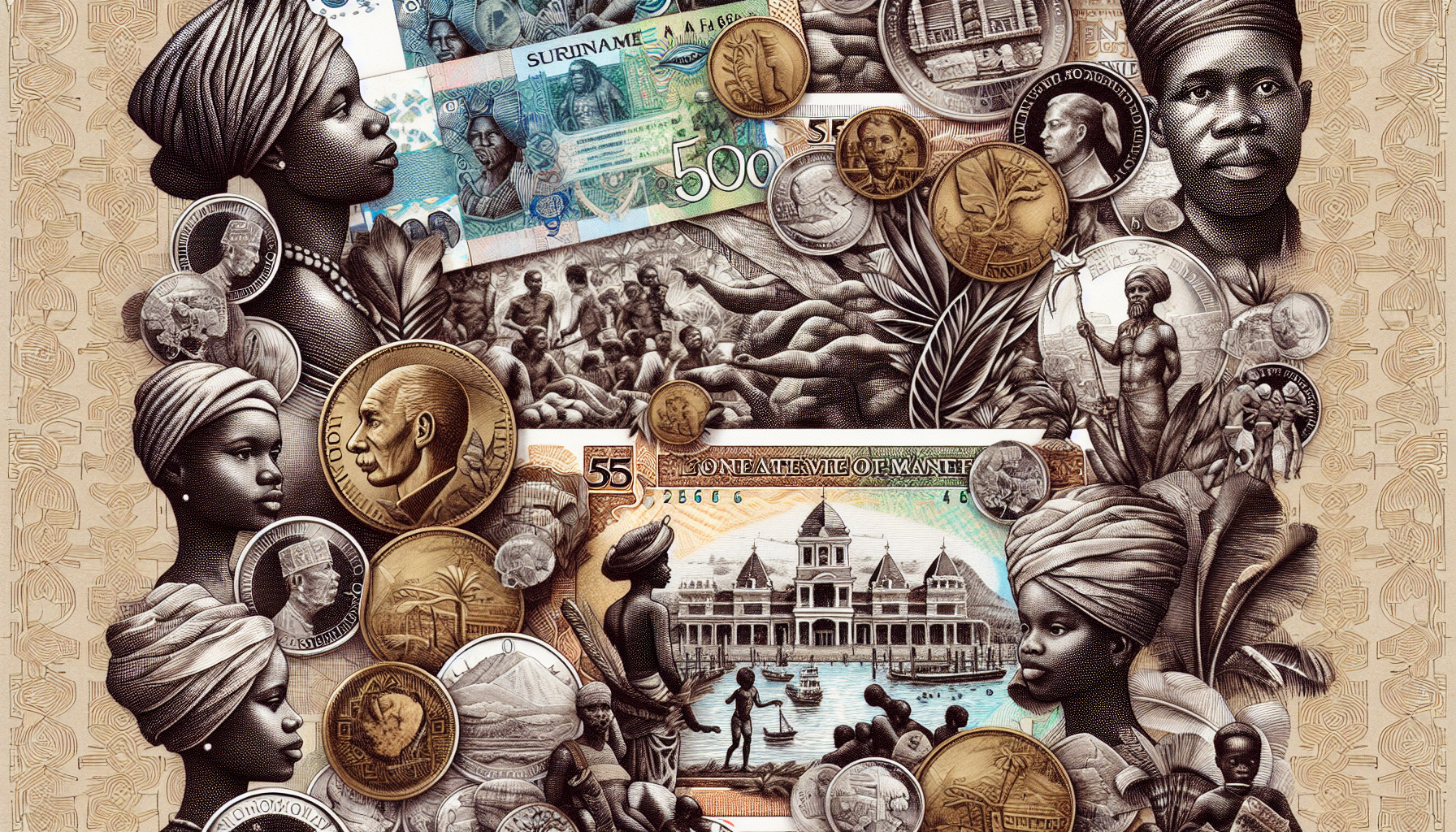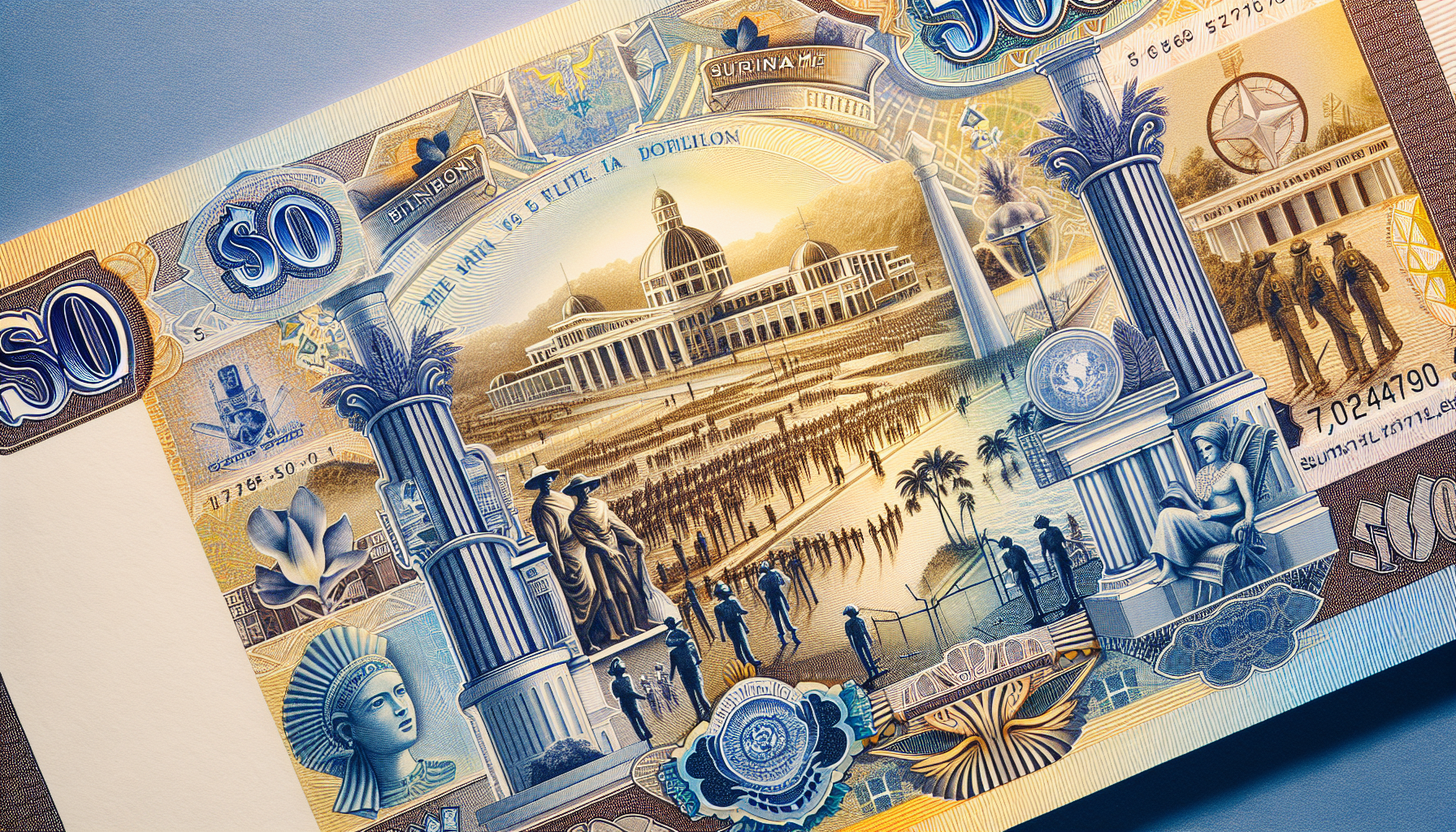Have you ever wondered about the unique and diverse currencies of different countries? Join us on a captivating journey as we explore Suriname and discover the fascinating world of its currency. From the Surinamese dollar to the intricacies of its design and the rich history it represents, prepare to be enthralled by the stories told by Suriname’s currency. Get ready to embark on an adventure that will not only take you across borders but also into the heart of Suriname’s vibrant culture and heritage. Let’s dive in and uncover the hidden treasures that lie within Suriname’s currency.
History of Surinamese Currency

Pre-independence currency
Suriname, a small South American country nestled between Guyana and French Guiana, has a rich history rooted in colonialism. Prior to gaining independence in 1975, Suriname was under Dutch rule for centuries. As a result, the Dutch influence is deeply ingrained in the country, including its currency.
The Surinamese Guilder
Overview of the Surinamese guilder
The Surinamese guilder (SRG) was the official currency of Suriname from 1940 until 2004. It was introduced as a replacement for the Dutch guilder, which was used during the colonial era. The guilder was subdivided into 100 cents and was denoted by the symbol ƒ.
Banknotes and coins
The banknotes of the Surinamese guilder featured various iconic figures and landmarks, such as former presidents and local fauna. The coins, on the other hand, depicted national symbols and cultural icons. These banknotes and coins served as a reflection of Surinamese history and culture.
Value and exchange rates
Throughout its existence, the value of the Surinamese guilder was subject to fluctuations due to various economic and political factors. Exchange rates with the Dutch guilder and other major currencies varied over time, impacting the purchasing power of the currency. Despite these fluctuations, the Surinamese guilder remained a symbol of Surinamese identity and independence.
The Surinamese Dollar
Introduction of the Surinamese dollar
In 2004, Suriname adopted a new currency – the Surinamese dollar (SRD) – to replace the Surinamese guilder. The introduction of the Surinamese dollar aimed to establish a more stable and modern currency that aligned with international standards. This transition was a significant milestone for Suriname’s economic development.
Features of the Surinamese dollar
The Surinamese dollar is divided into 100 cents, similar to its predecessor. It is denoted by the symbol “$” and is available in both banknote and coin form. The banknotes showcase important historical figures, landmarks, and cultural symbols, reflecting Suriname’s diverse heritage.
Conversion from guilder to dollar
During the currency transition from the Surinamese guilder to the Surinamese dollar, a fixed exchange rate was established. Every 1,000 Surinamese guilders were exchanged for 1 Surinamese dollar. This conversion process aimed to ensure a smooth transition for businesses and individuals, minimizing any potential disruptions to the economy.
Currency Exchange in Suriname
Banks and exchange offices
Suriname has a well-established banking system with various commercial banks operating throughout the country. These banks offer currency exchange services, allowing travelers and locals to exchange their money conveniently. Additionally, exchange offices can also be found in major cities and tourist areas, providing alternatives for currency conversion.
Exchange rates and fees
The exchange rates offered by banks and exchange offices may vary, so it is advisable to compare rates before making any transactions. While fees might be charged for currency exchange services, they are typically reasonable. It is essential to inquire about any potential charges to avoid surprises and ensure that you are getting the best value for your money.
Currency restrictions and regulations
Suriname does not impose any strict currency restrictions or regulations on travelers entering or leaving the country. However, it is always wise to check with your local embassy or consulate for any updates or specific requirements. It is also important to note that carrying large amounts of cash should be done responsibly and with caution for personal safety.
Alternative Currencies in Suriname
US dollar as a widely accepted currency
In Suriname, the US dollar is widely accepted in addition to the official currency, the Surinamese dollar. Many businesses, especially those catering to tourists, accept US dollars for cash transactions. However, it is always recommended to carry local currency for smaller transactions and to avoid any inconvenience.
Euro and other major currencies
While not as widely accepted as the US dollar, the euro and other major currencies can be exchanged in banks and some exchange offices. It is advisable to carry smaller denominations of these currencies to avoid any difficulties during the exchange process. Having a mix of currencies can be useful for various purposes, such as paying for accommodations or dining at certain establishments.
Use of cryptocurrencies
The use of cryptocurrencies, such as Bitcoin, in Suriname is still relatively limited. While there are a few establishments that accept cryptocurrencies as payment, the acceptance is not widespread. It is always recommended to have local currency or a widely accepted currency when visiting Suriname to ensure a smooth and hassle-free experience.
The Central Bank of Suriname
Role and responsibilities of the Central Bank
The Central Bank of Suriname plays a crucial role in maintaining the stability and integrity of the Surinamese currency. Its main responsibilities include formulating and implementing monetary policy, regulating the financial sector, and ensuring the soundness of the banking system. The Central Bank also acts as the issuer of banknotes and coins in circulation.
Monetary policy and its impact on the currency
Monetary policy decisions made by the Central Bank of Suriname directly influence the value and stability of the Surinamese dollar. These decisions involve managing interest rates, controlling inflation, and supervising the banking sector. The effectiveness of the Central Bank’s monetary policy has a direct impact on the overall economic health and confidence in the currency.
Currency stability measures
To maintain currency stability, the Central Bank of Suriname employs various measures. These include carefully managing exchange rates, implementing prudent fiscal policies, and closely monitoring economic indicators. By monitoring and responding to changes in the financial landscape, the Central Bank strives to protect the value of the Surinamese dollar and promote economic growth.
Currency Issues and Challenges
Counterfeit currency concerns
As with any currency, counterfeit notes can pose a challenge. The Central Bank of Suriname continually works to address this issue by enhancing the security features of banknotes and educating the public on how to detect counterfeit currency. To protect yourself, it is essential to familiarize yourself with the security features of the Surinamese dollar and verify the authenticity of banknotes during transactions.
Inflation and its impact on the currency
Inflation is an ongoing challenge for any country, and Suriname is no exception. Higher inflation rates can erode the value of the currency, leading to a decrease in purchasing power. The Central Bank of Suriname employs various tools, such as interest rate adjustments, to manage inflation and ensure price stability, thereby safeguarding the value of the Surinamese dollar.
Economic factors affecting currency value
The value of the Surinamese currency can be influenced by various economic factors, both domestic and international. These factors include economic growth, balance of trade, foreign investment, and political stability. Fluctuations in these factors can impact the exchange rate of the Surinamese dollar against other currencies, affecting its value and the overall economic climate.
The Future of Surinamese Currency
Potential currency reforms
As economic conditions evolve, Suriname may consider potential currency reforms. These reforms could involve adjustments to the exchange rate regime, modifications in monetary policy, or even the introduction of a new currency. Such reforms are typically driven by the need to address economic challenges and enhance stability in the financial system.
Adopting the euro as the official currency
Some discussions have taken place regarding the possibility of Suriname adopting the euro as its official currency. This would involve joining the Eurozone, which comprises countries using the euro as their sole currency. However, such a decision would require careful consideration of the potential benefits and challenges involved, weighing the economic, political, and social impact for Suriname.
Prospects for joining a regional currency union
Suriname has also explored the idea of joining a regional currency union, such as the Caribbean Currency Union or the South American Monetary Union. These unions aim to foster regional integration and enhance economic cooperation by adopting a common currency. While the prospects for such a move remain uncertain, it reveals Suriname’s commitment to regional collaboration and the exploration of potential economic avenues.
Currency Tips for Travelers
Exchanging currency and carrying cash
When visiting Suriname, it is advisable to exchange a portion of your currency into the local currency, the Surinamese dollar. This will ensure that you have sufficient cash for transactions, especially in smaller establishments that may not accept foreign currencies. It is also recommended to carry smaller denominations for convenience and to store your cash securely while traveling.
Using credit cards and ATMs
Credit cards are widely accepted in major cities and tourist areas in Suriname. However, it is important to notify your bank or credit card provider about your travel plans to avoid any potential issues with your cards being blocked. ATMs can be found throughout the country, providing convenient access to cash. Make sure to check for any applicable fees or restrictions when using ATMs.
Tips for getting the best exchange rates
To get the best exchange rates when converting your currency to the Surinamese dollar, consider the following tips:
- Compare rates: Check the rates offered by different banks and exchange offices to find the most favorable one.
- Timing: Exchange currency during periods of low volatility to potentially get better rates.
- Avoid airports: Exchange rates at airports can be less favorable, so consider exchanging currency at banks or exchange offices in the city.
- Plan ahead: If possible, calculate how much local currency you will need in advance to avoid excess fees associated with multiple transactions.
Conclusion
The history of Surinamese currency reflects the country’s journey towards independence and economic development. From the days of the Surinamese guilder to the introduction of the Surinamese dollar, the currency of Suriname has undergone significant changes. With the Central Bank of Suriname overseeing monetary policies and efforts to maintain currency stability, the Surinamese dollar continues to play a vital role in the country’s financial landscape. As Suriname explores potential currency reforms and regional collaborations, the future of its currency remains dynamic and full of possibilities. Whether you are a traveler or a local resident, understanding the currency landscape of Suriname and following currency tips will ensure a smooth and enjoyable financial experience in this fascinating South American nation.
